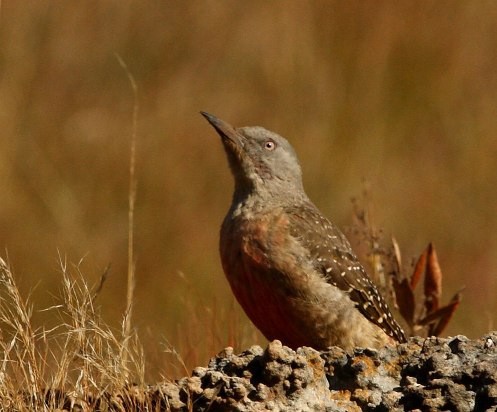Ground Woodpecker
A species of Ground Woodpeckers, Also known as Pale Ground Woodpecker Scientific name : Geocolaptes olivaceus Genus : Ground Woodpeckers
Ground Woodpecker, A species of Ground Woodpeckers
Also known as:
Pale Ground Woodpecker
Botanical name: Geocolaptes olivaceus
Genus: Ground Woodpeckers
Content
Description General Info
 Photo By Alan Manson , used under CC-BY-SA-2.0 /Cropped and compressed from original
Photo By Alan Manson , used under CC-BY-SA-2.0 /Cropped and compressed from original Description
The ground woodpecker is the largest woodpecker in the region, reaching 30 cm in length. The upper parts are greyish-brown with pale spotting, and the rump is red and more visible in flight. The upper sides of wings and tail are brown barred with white. The underparts are buff, flushed with pink or red. The underside of the tail is pale brown, barred with paler colour. The beak is black, long and slender, the irises pink or yellow and the legs grey. Males and females are broadly similar, but the female has slightly less red and pink than the male. The juvenile is similar to the female. 
Size
30 cm
Nest Placement
Cavity
Feeding Habits
Ground Woodpecker primarily feeds on various ant species, comprising 95% of its diet, and eats termites and other insects. It forages by hopping or walking on the ground, utilizing its beak to probe soil and wood for prey. Ground Woodpecker feeds mainly in the morning and late afternoon, requiring minimal time to meet its dietary needs due to slow digestion of large amounts of ants.
Habitat
The ground Woodpecker is predominantly found in open upland rocky terrains, such as boulder-strewn grassy slopes, rocky ridges interspersed within open grasslands, and barren mountainous areas. This species adapts to a variety of highland environments, including eroded landscapes and occasionally reedy marshes. In the southwestern part of its range, it can also be spotted along roadside habitats.
Dite type
Insectivorous
General Info
Feeding Habits
Bird food type
Behavior
It usually lives in pairs or small parties and is best located by its loud, raucous two-note call (chik-ree, chik-ree) with head-swinging. It often peers over or around rocks at intruders. The diet of the ground woodpecker consists mainly of ants with their eggs, larvae and pupae. These are extracted from dead wood or between rocks, using its long, sticky tongue. It also feeds on the ground, flicking away dead leaves in a manner reminiscent of flickers. Unusually for a woodpecker, one bird does sentry duty from a high point, looking for aerial predators, and this bird is relieved every 10 minutes or so by another member of the group. It breeds in spring and early summer (August to November), nesting is in a tunnel excavated in the vertical bank of a stream or watercourse. Usually three glossy white eggs are laid in a chamber at the end of the tunnel. 
Species Status
Not globally threatened.